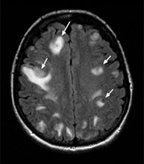ASCO: Gene Expression Signature May Predict Development of Brain Metastases in HER2-Positive Breast Cancer Patients
A 13-gene signature can predict the development of brain metastasis among patients with advanced HER2-positive breast cancer who have estrogen-receptor (ER)-negative tumors. The results were presented at a breast cancer session at the 2012 meeting of the American Society of Clinical Oncology.
A 13-gene signature can predict the development of brain metastasis among patients with advanced HER2-positive breast cancer who have estrogen-receptor (ER)-negative tumors. The results were presented at a breast cancer session at the 2012 meeting of the American Society of Clinical Oncology.

MRI of brain metastases; source: Rao, et al.
Innovation in the Management of Brain Metastases
.
Oncology.
21:473-481.
As the risk of the development of brain metastasis for women with advanced HER2-positive breast cancer is quite high, a group at the department of oncology at the Military Institute of Medicine in Warsaw, Poland and colleagues have developed a way to predict which women are most at risk for brain metastasis and have now validated its utility. HER2-positive tumors tend to have a more aggressive phenotype-more frequent recurrence and shorter overall survival compared to HER2-negative tumor subtypes. Approximately 20% to 30% of invasive breast cancers are HER2-positive, overexpressing the HER2 receptor on the tumor cells. Survival of patients with brain metastases is on the order of several months when treated with radiotherapy.
RNA samples from 87 breast cancer patients were analyzed for differential gene expression of 502 known cancer genes, identifying both up- and down-regulated genes in primary tumors. The 13-gene signature includes four HER2-associated genes including cyclin dependent kinase 4 (CDK4), and three genes involved in double-stranded DNA repair (RAD51, FANCG, and BARD1). For the original 87-patient cohort, the median time to brain metastasis was 36 months for those positive for the 13-gene signature, and 66 months for those lacking the gene signature profile (P = .0068). Adding ER negativity of the tumor as a factor increased the predictive value (P < .001) in the original cohort.
Renata Duchnowska, MD, PhD, of the Military Institute of Medicine in Warsaw, presented data showing this signature was predictive for the quick development of brain metastases among 75 breast cancer patients. Brain metastases occurred in 34 patients after a median of 65 months. Dividing the patient set by expression of the 13-gene signature and ER status, the median time to brain metastasis was 41 months for those patients positive for the 13-gene signature and ER-negative disease, and 77 months for those who lacked the signature and had ER-positive disease (P = .02).
The research addressed the significance of RAD51 and BARD1 overexpression; the genes RAD51 and BARD1 are involved in homologous recombination repair. Using an in vitro three-dimensional culture model, the authors showed that adding expression of RAD51 increased invasive structures in the model by 6.5-fold, greater than for HER2 overexpression. No evidence for either additive or synergistic effect of overexpression of both HER2 and RAD51 was seen; whether their overexpression specifically promote brain metastases, however, is still unclear.
“Our study suggests that inhibition of RAD51 might be expected to prevent dissemination to the brain,” explained Jacek Jassem, MD, PhD of the Medical University of Gda?sk in Poland. “Currently there are no specific drugs targeting this gene, but they will likely be developed. We are currently testing whether RAD51 actually promotes brain metastases using a mouse model,” he said. “The high preponderance of brain metastasis among HER2-positive tumors remains to be elucidated.”
“This is clearly clinically relevant,” said Martine J. Piccart-Gebhart, MD, PhD, professor of oncology at the Universit Libre de Bruxelles in Brussels, Belgium, the discussant of the study. Piccart-Gebhart raised the question of whether these genes are predictive of brain metastasis specifically or just metastasis in general.
“The study addresses an important question and aims to develop a tool to predict brain metastases which could facilitate screening and prophylactic strategies,” said Piccart-Gebhart during her presentation. Piccart-Gebhart also wondered, however, whether expression of RAD51 on its own is a predictor.
Duchnowska stressed that the signature is not ready for commercial use or for clinical practice yet.
“Even further validation of the 13-gene signature on larger populations is warranted before [any] clinical application,” said Jassem. “We believe that these data, if confirmed in further studies, may be useful in the design of brain metastasis preventive trials and may prompt new treatment strategies.” The researchers are in discussion with cooperative groups to launch a prospective study investigating the efficacy of prophylactic hippocampus-sparing brain irradiation in a subset of breast cancer patients that have a high risk of developing brain metastasis.